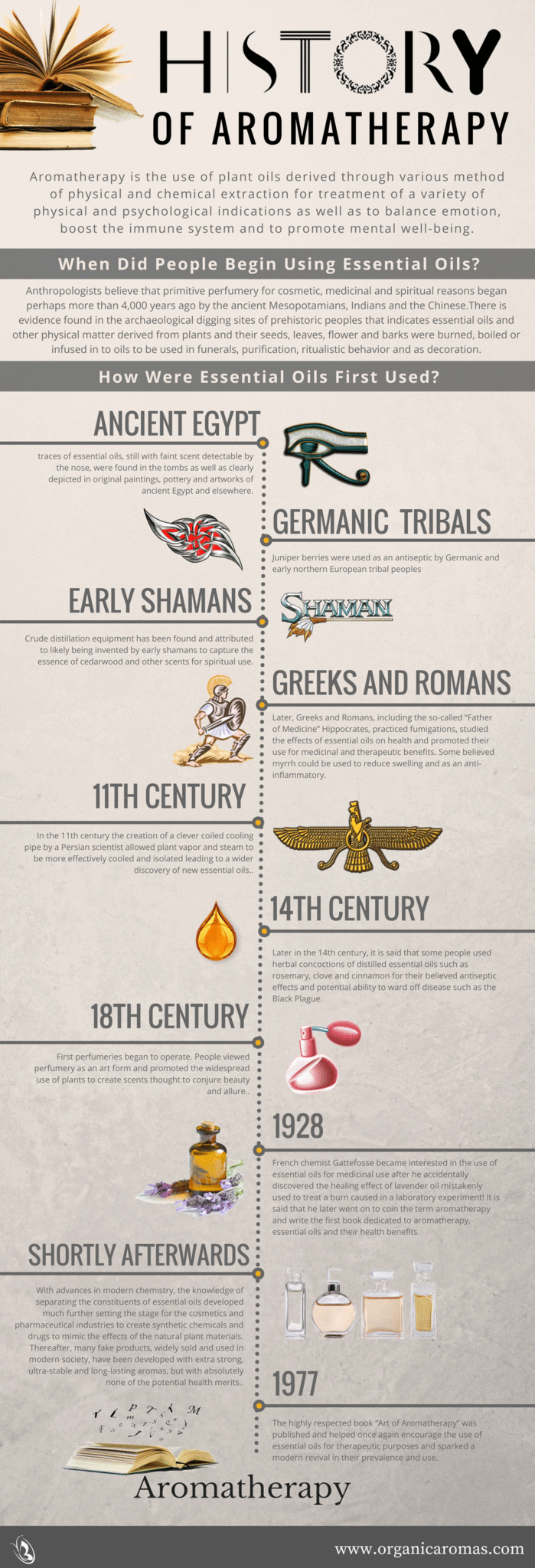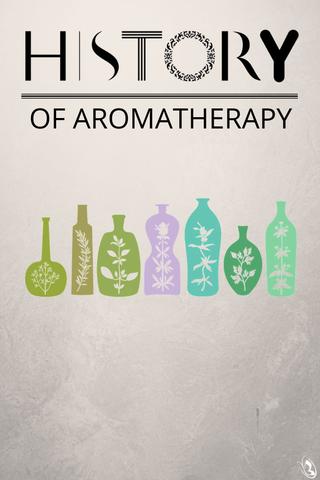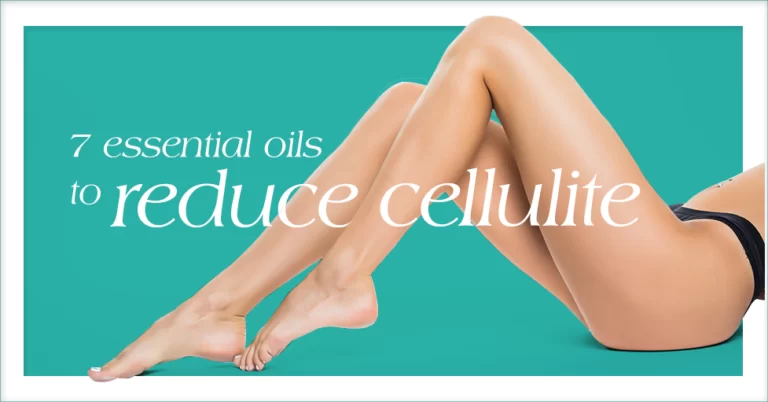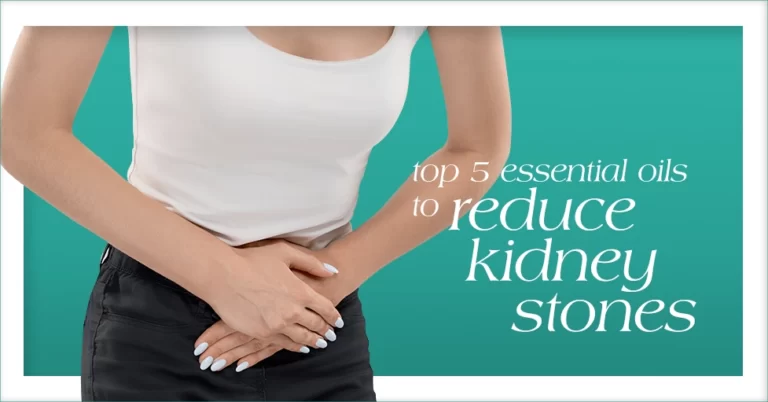History of Aromatherapy
Aromatherapy is the use of plant oils derived through various method of physical and chemical extraction for treatment of a variety of physical and psychological indications as well as to balance emotion, boost the immune system and to promote mental well-being.
When Did People Begin Using Essential Oils?
Anthropologists believe that primitive perfumery for cosmetic, medicinal and spiritual reasons began perhaps more than 4,000 years ago by the ancient Mesopotamians, Indians and the Chinese. There is evidence found in the archaeological digging sites of prehistoric peoples that indicates essential oils and other physical matter derived from plants and their seeds, leaves, flower and barks were burned, boiled or infused in to oils to be used in funerals, purification, ritualistic behavior and as decoration.
How Were Essential Oils First Used
In fact, traces of essential oils, still with faint scent detectable by the nose, were found in the tombs as well as clearly depicted in original paintings, pottery and artworks of ancient Egypt and elsewhere. Still other evidence indicates that juniper berries were used as an antiseptic by Germanic and early northern European tribal peoples. Finally, crude distillation equipment has been found and attributed to likely being invented by early shamans to capture the essence of cedarwood and other scents for spiritual use.
Later, Greeks and Romans, including the so-called “Father of Medicine” Hippocrates, practiced fumigations, studied the effects of essential oils on health and promoted their use for medicinal and therapeutic benefits. Some believed myrrh could be used to reduce swelling and as an anti-inflammatory.
In the 11th century the creation of a clever coiled cooling pipe by a Persian scientist allowed plant vapor and steam to be more effectively cooled and isolated leading to a wider discovery of new essential oils. Later in the 14th century, it is said that some people used herbal concoctions of distilled essential oils such as rosemary, clove and cinnamon for their believed antiseptic effects and potential ability to ward off disease such as the Black Plague.

Essential Oils Become Popular
However, it was not until the 18th and 19th centuries that perfumeries began to operate. People viewed perfumery as an art form and promoted the widespread use of plants to create scents thought to conjure beauty and allure.
Then, in 1928, the French chemist Gattefosse became interested in the use of essential oils for medicinal use after he accidentally discovered the healing effect of lavender oil mistakenly used to treat a burn caused in a laboratory experiment! It is said that he later went on to coin the term aromatherapy and write the first book dedicated to aromatherapy, essential oils and their health benefits.
Shortly afterward, with advances in modern chemistry, the knowledge of separating the constituents of essential oils developed much further setting the stage for the cosmetics and pharmaceutical industries to create synthetic chemicals and drugs to mimic the effects of the natural plant materials.
Thereafter, many fake products, widely sold and used in modern society, have been developed with extra strong, ultra-stable and long-lasting aromas, but with absolutely none of the potential health merits. In 1977, the highly respected book “Art of Aromatherapy” was published and helped once again encourage the use of essential oils for therapeutic purposes and sparked a modern revival in their prevalence and use.
Pin It!




Very interesting.
WOW never dreamed that essential oils were this old. And the more I read the more I c=found about them
I knew they had been used for a very long time but didn’t realize just how long. This is a really interesting post!
I had no idea essential oils had been around that long; 4,000 years ago, amazing!!
Essential oils are part of my every day life. Thank you for the informative history!
Essential oils are part of my every day life. Thank you for the informative history!
wow I didnt know it went so far back
I wish aromatherapy was used more prevalently today and with the quality and knowledge that our ancestors did.
Wow, I did not think it was so old 🙂
Love learning the history!
Love learning the history!
I have always appreciated and been impressed by the fact that essential oils have been used throughout history — they aren’t just a modern “fad.” And they wouldn’t have had such an extensive history if they didn’t do what they’re intended to do. They’ve stood the “test of time.”
I already use essential oils for aromatherapy for my anxiety and stress, as well as tea tree oil for my skin ailments. This is a greater insight into one of the many avenues of the utilization of essential oils.
I already use essential oils for aromatherapy for my anxiety and stress, as well as tea tree oil for my skin ailments. This is a greater insight into one of the many avenues of the utilization of essential oils.
So amazing to hear that this has stood the test of time. Thanks for the share.
Interesting! I never thought about the history of aromatherapy.
Loved the info
I love using essential oils and natural products vs pills and other medications. Cant wait to try these!
I have recently heard that essential oils in different combinations may help me with rheumatoid arthritis and lupus. I love them all so need to learn which combinations will help with my illness.
Nice to learn about Aromatherapy’s history. Sage and Lemongrass mixed make a lovely refreshing scent!
Nice to learn about Aromatherapy’s history. Sage and Lemongrass mixed make a lovely refreshing scent!
Being that essential oils have been around for thousands of years, I think it is safe to say that essential oils are a better and more natural way to healing as well as relaxation.
I’m a firm believer in aromatherapy. Aroma’s can do so much. Most of the “old time” remedies work just as good, if not better, than all the chemicals used to make medicine these days. I just turned on my oil burner. lol
I’m a firm believer in aromatherapy. Aroma’s can do so much. Most of the “old time” remedies work just as good, if not better, than all the chemicals used to make medicine these days. I just turned on my oil burner. lol
Excellent and informative read, thank you!
Excellent and informative read, thank you!
People back then probably discovered a lot of medicinal ways to use plants and oils! It’s not like they could catch an Uber and go to the nearest pharmacy! Now science has its hands in everything. Plus their “meds” have more side effects than cures!! I pinned the History of Aromatherapy. Thank you for sharing!!
Never thought about the history of aromatherapy. Good information and interesting.
This information on “ The History of Aromatherapy “ is really interesting. I just ordered a diffuser from Organic Aroma with lavender scent for my daughter. Another daughter recommended this company.
This information on “ The History of Aromatherapy “ is really interesting. I just ordered a diffuser from Organic Aroma with lavender scent for my daughter. Another daughter recommended this company.
I could use any refreshing aroma’s
Great information! Thanks for sharing! Lavender oil is great for soothing, use it to relax!
Great information! Thanks for sharing! Lavender oil is great for soothing, use it to relax!
A great an interesting read. I’ve always loved the use of essential oils in natural home products and scents. Good to get some insight on some history.
Wow, those craft Ancient Egyptians had their hands in everything it seems.
Thanks for the history lesson very informative
Nice history you shared! Thank you so much!
Thanks for all the information
wow I had no idea thanks for the info
great history lesson!